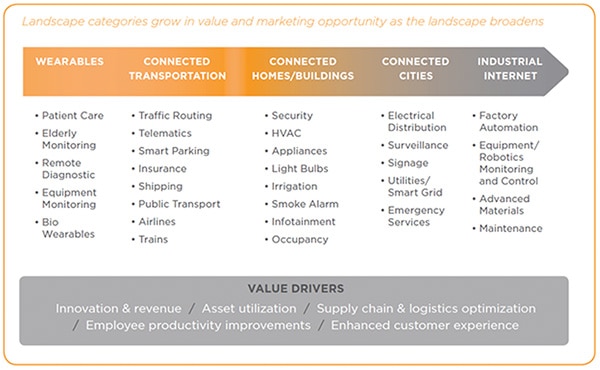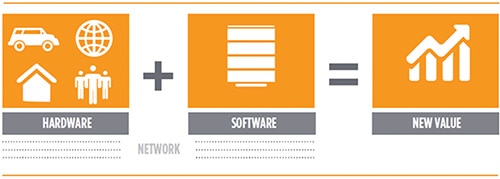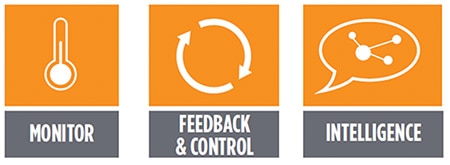TE Connectivity and the Internet of Things
2016-03-08
Steam engines, mass production, and Internet technology each brought epic revolution to business. Today we’re in the midst of what is often called the fourth industrial revolution – the convergence of physical things with the Internet: the Internet of Things.
Beyond the Hype
Internet of Things. Industrial Internet. Internet of Everything. The terms referring to the convergence of physical things with the digital world of the Internet are different from North America to Europe to Asia. Yet at their essence, they are all about the same thing: the pervasive opportunity to create economic value by making things smart – from cars and clothes, to buildings and factories.
The Internet of Things is the network of physical objects or things embedded with electronics, software, and sensors. By virtue of being connected, these things create greater value and service by capturing and exchanging data with its user and/or other connected devices.
Experts predict significant growth of things connected via networks, and enormous new value generated by virtue of those connections. Twenty-five billion objects will be linked together via the Internet of Things (IoT) by 2020 says Gartner Group1. IDC predicts the global IoT market will grow to $1.7 trillion by 20202. McKinsey Global Institute puts the value of IoT in business-to-business settings like smart factories at $3.9 trillion by 20253.
While these projections vary in precision, given TE Connectivity experience with engineers worldwide, we expect the growth of connected things within the next five to ten years to be very significant. Connecting billions of devices brings a huge opportunity for our customers to grow their businesses, drive innovation, and remain competitive. Getting things to communicate with us, and to each other, creates a new basis of competition for TE customers: unique products, optimized manufacturing, and greater efficiency.
Global companies and governments have been vocal in their promotion of IoT strategies. Their advertisements and voices have even coined new language: Internet of Everything, Industrial Internet, and Industry 4.0. China has its own strategy – “Made in 2025” – which requires more connecting things and continued progress in smarter factories and automation.
In our view, these terms point towards the same outcome: a fourth industrial revolution. It is an exciting time in history where breakthroughs are happening with more innovation on the horizon.
IoT Adoption Landscape
TE customers’ IoT initiatives fall into the same categories characterized by Harvard Business Review and Goldman Sachs as the early adopting markets. These coincide with the market segments TE serves.
Our customers are creating new value in a number of these application areas, including the fitness and medical applications in wearables, connected cars, emission controls and utility optimization, and smart manufacturing.

Figure 1: The expanding landscape of the Internet of Things.4,5
The value drivers across market segments are shared. It is:
- The opportunity to make new products and services that generate revenue.
- The opportunity to improve and differentiate customer experience, like avoiding equipment downtime through predictive maintenance.
- Improving time to market and decreasing logistics expense.
- Enhancing customer service and satisfaction with remote diagnostics and repairs on your car, for example.
- Keeping people out of the hospital through real-time data sharing between patient and medical provider for health monitoring and preventive care.
Data Everywhere
The move toward the Internet of Things is ultimately about connectivity that we call “Data Everywhere”– getting things to communicate with us, and each other. This is causing a fundamental shift in how companies will compete with new products, optimized manufacturing, and autonomous systems. The value-generating potential of Data Everywhere connectivity is huge for our customers. To realize that potential, fundamental building blocks are required and we are experts in those building blocks.
IoT Value Chain Requires Power, Sensing, and Adaptive Networks
The value chain for Data Everywhere starts with hardware, adds software and services, and results in the ability to capture and act on data gathered at network end-points to create new value.

Figure 2: The IoT value chain.
TE enables the hardware side of that equation, providing the fundamental connectivity that is a precursor to Data Everywhere. All IoT end-points, in all those different form factors across industries and use cases, require three things: they must have power, they must be able to sense information, and they must rely on a reliable, secure network infrastructure to move that data fast.
Power
Before anything can be connected, it needs to be powered. The specifications for adding power to things are as varied as a space-efficient, safe power connector that can be installed quickly and intuitively by a line worker, to a sophisticated battery connection that can withstand liquid immersion (ever jump in the shower with your Fitbit?), to wireless power for low voltage transmission within close proximity.
Power is the fundamental element behind Data Everywhere, yet installation, usage, and performance requirements for power are different across industries and applications. The base criterion is to enable persistent power delivery that fits the form, function, and environment of the application. TE’s modular product portfolio is in demand for IoT applications for its efficient connectors, ability to be quick to use without instructions, and typical availability within 24 hours.
An alternative to connectors, contactless power, is liberating design engineers to realize new possibilities for mechanical motion. Innovations in contactless power enable unencumbered movement of machine components, like robotic arms in manufacturing. Our contactless connectivity platform, ARISO, delivers power and data through the air reliably, even in a heavy-duty factory environment. Today’s robotic arms can be powered with up to 100 watts from two centimeters away – enough distance to allow robotic arms to move in ways they could not before, increasing the use of robotics in more precise and advanced applications. The next 18 months will see contactless power wattage increase and distance shrink. This rapid feature evolution illustrates TE’s disruptive capabilities, and is a game-changer in factory automation.
IoT applications are accelerating power innovation. Imagine future scenarios enabled by integrated transfer of power and data that enable more autonomous systems and machines. Imagine a sensor and switch duo or cool-down element that takes an action via temperature monitoring. This automated intelligence could be wired to motors and conveyor belts, not only in a controlled environment but within an exposed and harsh environment. Another possibility is smart charger cables that monitor and control power at the point of interconnect. Data Everywhere capability can be extended to legacy machinery and allow more efficient use of power through new visibility of usage.
Sensors
Sensors provide the ability to capture data at end points. They are the intelligent bridge between physical and digital.

Figure 3: The three ways sensors can work in IoT devices.
Sensors work in three ways:
- Open loop sensing, which sends information from the thing to you, like starting your car outside from a key fob in your house on a cold morning.
- Closed loop sensing, used in monitoring and controlling applications, like starting your car from the fob and getting a message back from your car saying the engine has started.
- And finally, autonomous loops, which add intelligence at the point with sensors to create autonomous systems, like starting the car using your fob from the house and your car, sensing the external temperature, turning your seat warmer from level three to five because it is 20 degrees colder than yesterday.
IoT end-points inherently rely on sensors to collect information. We see increased closed and autonomous loop applications driving sensor growth. Sometimes that closed loop system will be completely in the machine. A patient with a heart problem uses a cuff and patch to capture and securely transmit heart data from home. The doctor’s system returns data that calibrates medicine dosage on the patch. Or in the factory automation context, a machine assembly self-adjusts speed based on inventory volume. Within smart buildings, closed loop sensor systems will monitor light and appliance power to stay within pricing tiers and maximize rebates.
TE’s portfolio of intelligent, efficient, and high-performing sensors is used across several industries–from automotive, industrial and commercial transportation, and aerospace and defense, to medical, industrial, and consumer applications. While temperature, humidity, and pressure sensors are the most common sensors used, we also see increasing use of sensors for vibration, liquid level, and fluid property.
Adaptive Network
Today’s networks are adaptive, recognizing the addition and subtraction of new end-points on the fly–just think of how easily you can connect/disconnect to and from your enterprise network wirelessly across a corporate campus. The opportunity and challenge for network providers in an IoT world is to extend that adaptive quality to network components. Network components and subsystems will become addressable network nodes.
In those IoT scenarios where high-performance network access is mission critical, active components introduce intelligence to networks that ensure optimal operations and maintenance. In a data center running 56G connectors that begin to get hot, for instance, the components would be able to alert operators before issues occur.
More robust network design preserves signal integrity to enable performance stats, for predictive maintenance or self-corrective action, and to increase network infrastructure lifespan. Data architectures that deploy modular components ensure the most efficient array of speed, efficiency, and performance required.
Three Hardware Criteria for Internet of Things Value Creation
The new economic value created from IoT applications is beginning to emerge as applications move from concept to commercial implementation. While a lot of the early IoT traction has been in consumer spheres, the next few years will see more business and industrial IoT deployments. Three criteria must be met by hardware enablers of the Internet of Things:
NEED #1. Cannot Fail
Human life, brand value, economic vitality
The stakes could not be higher. The safety and well-being of users, whether they are driving autonomous cars or getting remote medical treatment from their doctors, there is no margin for failure. For whole industries, like manufacturing, they are defending their competitive identity and value. The reliance on end-point connectivity as a driver of mission-critical value simply means their Data Everywhere connectivity cannot fail. Sustained performance amid harsh environments must be an engineering hallmark. Power and sensing must be ruggedized to withstand the harshest operating conditions, from weather, vibration, shock, ambient temperatures, humidity, hostile chemicals, and biological sources.
NEED #2. Smaller, Multifunction, and Efficient
The need to design connectivity and sensing into devices and machines is pushing the limits of materials engineering and physics. We are seeing rapid advancement in the use of lighter but stronger materials and wireless power, for example.
Demands for lighter weight electronics and multifunction capabilities that maximize function in efficient space are required for the closed loop capabilities of feedback and monitoring function. We are increasingly packaging components together to save space and expand function.
NEED #3. Affordable High Quality at Any Volume
Global agility, adaptability, and flexibility
For Data Everywhere to proliferate, makers of newly connected products will need to accommodate regional and user-specific configuration requirements. The use of advanced manufacturing methods, like laser cutting and 3D printing, makes operating with flexibility at scale economically viable. Further, beyond the agility to mass configure, hardware manufacturers ensure operations security and sustainability when facilities are dispersed across geographic markets. Globally distributed manufacturing agility will become a differentiating capability.
Standards bodies, government entities, and software and hardware companies are all working to define the shared standards and protocols required to advance the network of connected things. Much of the discussion is about software issues, from interoperability to data ownership, control, security, and privacy. TE participates in the leading groups, including the Industrial Internet Consortium, as part of the IoT ecosystem. We occupy an essential and distinct position as an IoT enabler. As a hardware manufacturer, we are able to accommodate developing, ad hoc, and accepted standards and remain interoperable with all.
Implications for Engineers
Data everywhere means changes to how engineering teams approach design. Companies have to work within a broader ecosystem of partners. Multiple disciplines are required from mechanical, electrical, and materials engineering. Co-creating and collaborating with experts outside your organizations is key to accelerated innovation.
Data Everywhere: TE Everywhere
We have watched the Internet of Things unfold from a unique vantage. Our over 7,000 design engineers collaborate daily with customers in 150 countries. This scale provides insight on the difference between trending topics and true market evolution. We are now seeing more of our customers building Data Everywhere connectivity into their products. IoT is driving a new connectivity demand across sectors.
Whether it is autonomous vehicles, intelligent homes and buildings, or self-maintaining factories, the fundamental elements of connectivity – power, sensors, and adaptive networks – will be required for all Data Everywhere applications. That presents a strong case for TE everywhere.
免责声明:各个作者和/或论坛参与者在本网站发表的观点、看法和意见不代表 DigiKey 的观点、看法和意见,也不代表 DigiKey 官方政策。








